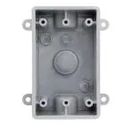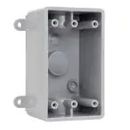Running Electrical Wire into Surface-Mounted Receptacle
After more than two hours of reading articles, watching videos, and looking for instructions that don’t exist, I still haven’t learned how Romex coming from the interior of my wall should make its entry into the back of a surface-mounted plastic box for a weatherproof receptacle like the one pictured here. Do I need some kind of weatherproof clamp that screws in, or can I remove one of the knockouts and caulk around the Romex where it enters? I will be attaching this to the surface of a SmartSide panel.
GBA Detail Library
A collection of one thousand construction details organized by climate and house part











Replies
Remove the knockout and install a standard thread in wire clamp. Run the wire through, clamp, install onto siding surface. You'll also have to drill a bigger hole through your siding and sheathing to make room for the wire clamp. Helps to zip off the excess clamp screw length with an angle grinder to reduce hole size.
I like to spray foam the hole where the wire comes through (best is from inside, but can be done from the outside before you seat the box) to seal it up.
You also need to seal the wire clamp with duct seal putty inside the device box.
Caulk the box along the sides and top to your siding, leave the bottom open to allow for drainage.
Thank you, Akos. It's great to have a solution that uses materials I already have, except for the duct seal. Could I use ample silicone caulk to seal around the clamp, hole, and cable, or if that would be too permanent in case the cable ever had to be moved, would a putty made from combining butyl rubber strips that are left over from sealing my steel roof along the eaves do?
Duct seal mastic is cheap, saves any discussion if the inspector looks at it up close.
P.S. Get the boxes without ears (or snip them off) and mount them using screws on the inside. Neater install.
If you use a metal box instead of a plastic one, you can bring the wire in through the knockout on the back of the box. You can get a cable gland (cable grip with a rubber grommet that tightens around the wire) for NM cable — the box stores have these.
With a plastic box, you really want to use an LB, which is the conduit fitting with a cover that you can use to go around 90 degree bend to enter a surface. Use a suitable cable gland with the LB.
I personally would use a metal box and cable gland in the rear knockout since it’s simpler and cleaner. I run a bead of sealant in an upside down “U” shape around the back of the box to seal around the top of the hole and the siding. I leave the bottom free of sealant to prevent water from collecting. Filling the hole in the siding with canned foam is a good idea for air sealing too.
Bill
Thank you, Bill. Why would one need an LB inside the wall if using a cable gland to connect to a plastic box?
You would use it on the outside of the box, to make the bend to enter the wall. You're not supposed to leave the cable exposed without physical protection when you transition from the box to the interiod of the wall. An LB solves that issue if you can't use a knockout on the back of the box, but it's not a very clean installation.
The easiest thing to do is to use a metal box that has a rear knockout.
BTW, you're not supposed to drill holes through those boxes to mount them to the wall. Chances are such a mounting won't be challenged by an inspector, but there are a number of reasons why it's not really permissible.
Bill
Thank you, Bill.
The plastic box I'm using has a threaded knockout in the back as well as two unthreaded ones. I'm guessing the photos I posted were too small for those to be easily seen, a mistake I won't repeat.
I do plan to use the mounting ears.
Use one of the cable glands made for NM/UF cable in that rear threaded knockout and you’re good to go. I’d put some canned foam around the cable in the hole, and some polyurethane sealant around the top and sides of the back of the box to seal to the siding and call it good. The grommet itself will seal between the box and the cable.
Bill
I just installed one of these, and I came across a similar dilemma - how to mount it cleanly.
In my case, I was using a bit of scrap PVC trim to make a mounting block. The provided screws are self tapping, and and those mount tabs are pretty much trash in both function and appearance.
I happen to have my tap set on hand with some 1" machine screws, and was able to tap each hold for a #8 x 32 screw, and attach from behind the PVC. The PVC block then scews into the blocking, and the hold thing can be removed as needed. It made me wonder why those holes aren't already threaded, especially if they're already providing screws.
Edit: Mine didn't have the mounting tabs on the side. It was rigid.
I used a plastic box that had threads in the back of it, I think that is the box in the photo. I used a threaded PVC conduit connector. The PVC thd x slip connector went thru the WRB & sheathing. I gooped sika flex polyurethane sealant around the PVC connector to seal it to the WRB. I used Henry Blueskin as the WRB. The Romex was stapled to the stud and routed into the box. Then I sealed the Romex inside the PVC slip connector.
Thank you, Tim. Sealing the WRB to a smooth, round surface seems advantageous.
I expect this discussion will fairly often provide a much-needed answer to others with my initial question, especially if the word "exterior," "outdoor," or "weatherproof" is put back into the title, as that's the key distinction. A cable gland like Bill recommended is hard to find for NM and UF on the major retailers' sites, but here's one at an electrical supply house: https://www.elliottelectric.com/P/Item/ARL/NMUF75/ The little PVC fitting Tim used is much more economical.
Jeff,
Your questions always bring up interesting points. I invariably get something useful from the discussion.
Thank you, Malcolm. I usually spend at least a couple of hours trying to find an answer before asking here, where I always get excellent advice, including quite often from you, which I greatly appreciate.
Home depot sells those cable glands and stocks them in their stores:
https://www.homedepot.com/p/Halex-1-2-in-Service-Entrance-SE-Water-tight-Conduit-Connector-90661/100170032
Note that these are metal fittings though, and are supposed to be used with metal boxes.
A possible reason it's difficult to find "weatherproof" stuff is that the trades don't generally use that term. Regular electrical stuff is "drip tight" or "rain tight". Rain tight devices aren't fully sealed, and don't have to be. If you want full sealed things, you have to go up to "explosion proof", or some of the specialty marine fixtures, any of which are $$$ !!!
The problem using a slip fitting, if you're thinking of what I'm thinking of, is that it doesn't provide proper cable support and isn't listed for the purpose. If you're getting inspected, you can't make your own connector with a slip fitting and some sealant -- you have to use a listed fitting that has been certified by a testing lab (usually UL or CSA), otherwise it's red tag time with the inspector.
In practice, that sealed up fitting will probably work fine, but that doesn't make it "right".
Bill
Thank you, Bill. I had searched for "cable gland" on the HD site and seen the fitting you found. They call it a "1/2 in. Service Entrance (SE) Water tight Conduit Connector," which didn't sound appropriate, but I can see that it would work if I had a metal box. You make a good point about listed purposes. It would be interesting to learn how often clamps like Akos suggested or fittings like Tim suggested are used in work that gets inspected and how those solutions fare. Given my sense of the popularity of plastic boxes and the lack of cable glands for them on the big box sites or Amazon, I would guess that somewhat improvised solutions are pretty common.
I think they have a messed up description for that part. It says "SE and SEU cable", but further down it lists "14/2 and 12/2 NM and UF" cable (note that those aren't really "quotes", just me paraphrasing). SE/SEU cable is service entrance cable as you mention, and is generally only seen in larger sizes starting around 4 gauge or so. It's typically aluminum wire too -- you rarely see copper versions these days.
Personally, I try to avoid surface mount boxes as much as possible -- I like the clean look of recessed devices. That can be tricky in renovation work though, so sometimes we get stuck with surface mounted stuff.
My guess is that you're probably right about there being a lot of improvised installations out there. The most important things to remember if doing that are to maintain physical protection of the cable to avoid damage, and to maintain ground continuity (make sure any exposed metal pieces are grounded). Do those two things and you've probably covered 90+% of the safety issues, and those are the most important. I'd still recommend trying to stick with the proper materials though.
Bill